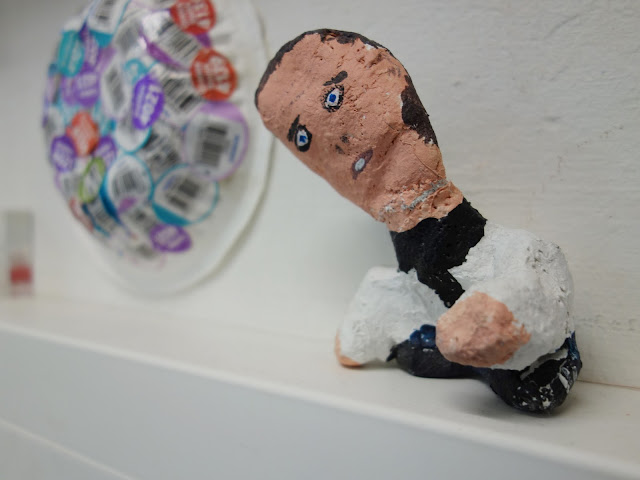Resource
Room / Interventions
Filipino Artist Jason Dy, SJ sees the Staff
Room as a potential space of respite and recreation for all staff that
complements the other offices within the Bluecoat. During his internship, Dy has made two
interventions. One is a set of proposed
layout sketches indicating possible designs of the Staff Room to bridge the gap
between the intended use and actual use (Figs. 23 and 24). However, he realizes this kind of approach is
not collaborative being from the point of view of a transient visitor offering a
design to the regular staff members. Therefore
he would propose a brainstorming workshop with the staff and would present to
them a blank floor plan of the Staff Room. They could design the space according to how
they use the place as well as in relation to the intended institutional purpose
of the room. It would be an activity
where the staff could articulate their own usage of the place while negotiating
the usage of others. They would also be requested
to suggest ways of realizing their design plans. A synthesis of their articulated designs and
plans would be produced by the workshop facilitator and be signed by each
participant. The document would be
submitted to Bluecoat’s board of directors for negotiation and approval.
Secondly, to re-awaken interest in the Staff
Room, Dy initiated a collection of objects found in various offices and
displayed them along the plastic cable trunking on the two larger walls inside
the room.
As objects, embedded in them are the
processes of their production either hand-crafted or manufactured; the
narrative of their acquisition and use; the site of their placement or displacement;
and their relation to the subjects who collected and use them (Godfrey, 2009). Because they are selected and displayed in a
specific way in relation to the space, to each other, and are part of a
specific creative intervention by Dy, as an artist and curator-intern, to a
specific inquiry into the spatial use of the place, they are in a sense curated
within the room.
In their original site, the placements of
these objects are either arbitrary or ordered. But there is a certain internal logic of operationality, that is, these objects
are put on a specific spot depending on how they contribute to the whole
operation towards the accomplishment of specific tasks. Like in the participation and programme
departments the primary skills involved are researching, planning, scheduling,
managing and evaluating of exhibitions, education programmes and workshops, and
the main supplementary electronic fixtures are computer and telecommunications
systems. Thus, these objects are
situated around these two main fixtures. Their proximity depends on their operational
value, or in a sense, their usefulness for finishing a task as well as
providing an aesthetic purpose. Some
objects like photographs and plants, though not a tool for accomplishing a task
are placed within the sight of vision (perhaps beside a computer screen)
provide a decorative and motivational function. Collectively, with all other things in the
room such as furniture and fixtures, these objects become important in creating
a working environment that supports the staff in performing their work and
creativity.
In their new site, they become objects of
personal investments for the Staff Room. In contributing these objects to the Staff
Room, Dy has co-opted the staff members to invest in the place. Their objects become part of a collection of
everyday artefacts disrupting the usual aesthetics of the room. Collections may increase depending on the
response of the staff members. The
collection is open-ended. No
instructions are given, no notice about the project and some do not even know
who initiated the project. They may
either contribute their own objects or wait for an invitation to participate in
this collaborative project.
Thus, these two interventions are not
disruptive to the actual usage of the place or to the general arrangement of the
furniture. They are rather minimal
interventions in the room by primarily working through existing elements. However minimal and seemingly mundane, they
are aimed at initiating conversations about the Staff Room - its intended use
and actual use as well as its potential resource as a space of respite and
recreation for the Bluecoat staff.
Special thanks to Bluecoat, Liverpool, UK










